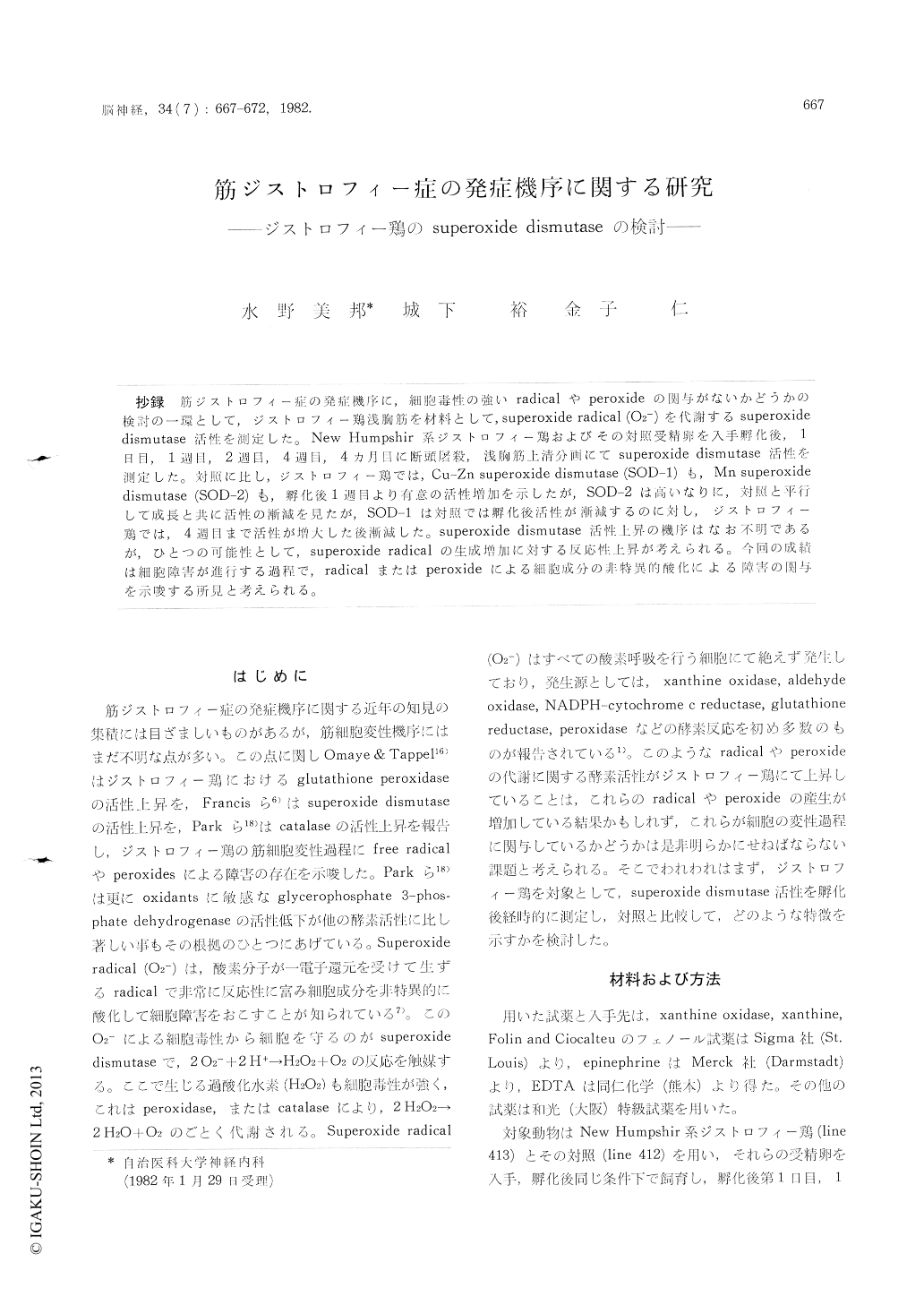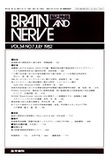Japanese
English
- 有料閲覧
- Abstract 文献概要
- 1ページ目 Look Inside
抄録 筋ジストロフィー症の発症機序に,細胞毒性の強いradicalやperoxideの関与がないかどうかの検討の一環として,ジストロフィー鶏浅胸筋を材料として,superoxide radical (O2—)を代謝するsuperoxidedismutase活性を測定した。New Humpshir系ジストロフィー鶏およびその対照受精卵を入手孵化後,1日目,1週目,2週目,4週目,4ヵ月目に断頭屠殺,浅胸筋上清分画にてsuperoxide dismutase活性を測定した。対照に比し,ジストロフィー鶏では,Cu-Zn superoxide dismutase (SOD−1)も,Mn superoxidedismutase (SOD−2)も,孵化後1週目より有意の活性増加を示したが,SOD−2は高いなりに,対照と平行して成長と共に活性の漸減を見たが,SOD−1は対照では卿化後活性が漸滅するのに対し,ジストロフィー鶏では,4週目まで活性が増大した後漸誠した。superoxide dismutase活性上昇の機序はなお不明であるが,ひとつの可能性として,superoxide radicalの生成増加に対する反応性上昇が考えられる。今回の成績は細胞障害が進行する過程で,radicalまたはperoxideによる細胞成分の非特異的酸化による障害の関与を示唆する所見と考えられる。
Since increased activities of superoxide dismutase, glutathione peroxidase and catalase were reported in avian muscular dystrophy, involvements of free radicals and peroxides have been posturated as possible mechanisms of cellular damage in this disorder. It seems to be important to see chrono-logical changes in activities of these enzymes after hatching to see if free radicals and peroxides are really playing roles in pathogenesis of this disorder. As the first step on this line of investigation, we studied chronological changes in activites of muscle superoxide dismutase. For this purpose dystrophic chickens of New Humpshir series line 413 and their controls line 412 were used. Four animals from each group were sacrificed one day, one week, two weeks, four weeks and four montl.s after hatching by decapitation. The superficial pectoral muscle was immediately weighed and superoxide dismutase activity in the supernatant fraction was assayed according to the method of Misra and Fridovich with modification by Sun and Zigman. Total superoxide dismutase was assayed first and then Mn superoxide dismutase (SOD-2) was assayed with 2 mM KCN. The difference between total and Mn superoxide dismutase activites was con-sidered as Cu-Zn superoxide dismutase (SOD-1).
Because total protein concentration in the super-natant fraction was higher in the control group compared to that of the dystrophic group, enzyme activites were expressed as total activity (u/g tssue) and syecific activity (u/mg protein). In the control group both Cu-Zn and Mn superoxide dismutase activities showed gradual declines of activities after hatching in both ways of expression. On the other hand in the dystrophic group Cu-Zn superoxide dismutase showed progressive increase in the ac-tivity until four weeks after hatching and was still twice as high as that of the control group four months after hatching. Cu-Zn superoxide dismutase in the dystrophic group at four weeks after hatching was three times as high as that of the control group when expressed as u/mg protein. Mn superoxide dismutase activity was also signifi-cantly higher in the dystrophic group compared as that of the control group, however, time course of the activity after hatching was similar in two groups, in that Mn superoxide dismutase activity showed gradual decline after hatching in both groups.
Our observations indicate the presence of in-creased activity of superoxide dismutase in avian muscular dystrophy of New Humpshir series. And this increase was observed before morphological changes of dystrophy become apparent. Incresed activity of superoxide dismutase would be a result of increased formation of superoxide radicals. If that is the case, formation of hydrogen peroxide and perhaps of hydroxy radicals will also increase. All of these radicals and peroxides can oxidize cellular components and contribute to cellular damage. The results suggest involvement of these radicals and peroxides in the pathogenesis of cel-lular damage in avian muscular dystrophy.

Copyright © 1982, Igaku-Shoin Ltd. All rights reserved.


